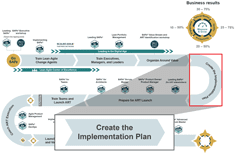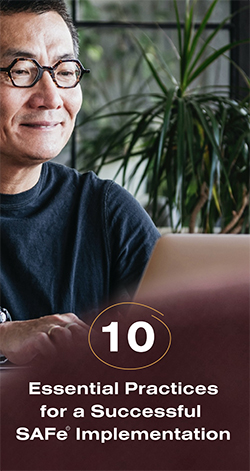
The more detailed we made our plans, the longer our cycle times became.
—Don Reinertsen
Create the Implementation Plan
This is article seven in the SAFe® Implementation Roadmap series. Click here to view the entire roadmap.
The previous six articles in this series described the first six steps of the SAFe Implementation Roadmap:
- Reaching the Tipping Point
- Train Lean-Agile Change Agents
- Create a Lean-Agile Center of Excellence (LACE)
- Train Executives, Managers, and Leaders
- Lead in the Digital Age
- Organize Around Value
This article addresses the next ‘critical move’: create the implementation plan.
Implementing an organizational change of this magnitude is a big deal, and some time will need to be devoted to strategizing and planning. But Reinertsen’s [1] quote reminds us not to overthink the problem. He notes, “The more detailed we made our plans, the longer our cycle times became.” It’s far better to plan a bit, execute a bit, and learn a bit. Then repeat. In other words, take an Agile, incremental approach to implementation, just as is recommended with solution development.
It generally starts when the enterprise picks one value stream and one ART to serve as the vehicle for the journey.
Details
The last article, Organize Around Value, described a process typically executed in one or more workshops, where the key enterprise development stakeholders gather to identify the flow of value through the organization. These stakeholders include SAFe Practice Consultants (SPCs), members of the LACE, newly trained Lean-Agile Leaders, and other essential team members.
Applying their new knowledge from training, the Lean-Agile Mindset, and Principles, enterprise stakeholders start to identify strategies for implementing this new way of working. This leads to the next step, creating the implementation plan. This is where the rubber meets the road in a SAFe implementation.
Up until now, the focus has been on conceptualizing the change. The next move, however, requires real and tangible changes to individual and organizational behavior. Specifically, creating the plan involves three activities:
- Pick the first value stream
- Select the first ART
- Create a preliminary plan for additional ARTs and value streams
Pick the First Value Stream
Each development value stream identified in the prior step is a candidate for the new way of working. A large enterprise offers many opportunities for improvement, and while there’s no one right way to begin, for many companies, the next smart move is to pick one initial target. After all, this significant change is likely untested in this organization’s environment. Selecting one target allows the newly trained SPCs and leaders to focus their full attention and resources on a specific starting point for SAFe implementation.
Once a value stream is selected, some additional considerations are required to define further the development value stream boundaries, people, deliverables, potential ARTs, and other parameters. To assist, stakeholders can use the Value Stream Canvas in Figure 1 to capture their emerging understanding.
Filling in the fields typically requires additional conversation and alignment. It calls for an understanding of how things work now and how they’re intended to work in the future. Note—as highlighted in the bottom section of Figure 1 (also described in the previous article, Organize Around Value), some additional analysis may be needed in large environments to define prospective ARTs and governance in a Solution Train.
Select the First ART
Once organizations identify their first development value stream, it’s time to generate the initial ‘short-term win’ by focusing on the first ART. That will yield institutional knowledge that can be applied to other ARTs. Sometimes, the first value stream is also the first ART, and no further decisions are needed. In larger development value streams, however, the next step will require the active support of many more leaders and other stakeholders in that value stream. Many enterprises look for a first, ‘opportunistic’ ART, which can be found at the intersection of the factors illustrated in Figure 2.
The target for the first ART is often one that best meets the following criteria:
- Leadership support – Some senior leaders are already trained in SAFe and will be anxious to put their training to work. Additionally, many leaders will have had previous experiences with Agile development, perhaps even in SAFe.
- Clear products or solutions – SAFe is most easily applied to a clear and tangible solution, something the company sells directly or values highly.
- Collaborating teams – Somewhere in the enterprise, teams are already collaborating on building a solution. Some may already be utilizing Agile methods, some not. Given the business’s current challenges, the teams may be ready to embrace scaled methods for collaboration and integration.
- Significant challenge or opportunity – Change is hard. The smart enterprise selects a subject that is truly worthy of its effort, ideally a sizeable existing challenge or a new opportunity. Creating a short-term win in these areas of the organization will produce immediate benefits and facilitate faster and broader adoption.
Once this ART is selected, the enterprise is nearly ready to move forward.
Create a Preliminary Plan for Additional ARTs and Value Streams
Before moving on to launching that first ART, note that it’s likely that a broader implementation plan may already be forming. Although it’s still early in the process, strategies for rolling out additional ARTs and for launching additional value streams may already be starting to take shape. In short, change is beginning to happen, and the signs are everywhere:
- The new vision is being communicated around the company
- Principal stakeholders are aligning
- Something big is in the air, and people are catching on
As described in Create a Lean-Agile Center of Excellence, the LACE, various SPCs, and senior leaders typically guide the transformation using Agile and SAFe as their operating framework. Leveraging SAFe’s ten critical success factors, the LACE holds the first PI Planning event. They invite the larger guiding coalition, stakeholders, Business Owners, and initial ART leaders to help further define the implementation strategy. One natural output would be a PI Roadmap for the implementation, as illustrated in Figure 3.
However, before committing to the roadmap, it’s probably a good time for stakeholders to reflect on the existing culture and the ‘how’ of the larger implementation strategy. Yes, it’s a committed change initiative, and the change is not optional, but how it is received depends on many factors. Mandated change can often be uninspiring to those on the receiving end of the decision. Through navigating what it means to Lead in the Digital Age, SPCs, alongside senior leaders, will guide the associated communication paths and cultural impacts.
Don’t be too concerned about perfecting the implementation strategy at the start. Any preliminary plan is just a hypothesis and will be incrementally improved as the implementation evolves. The larger planning cycle will be revisited later in Launch More ARTs and Value Streams.
Moving Forward
In any case, with one or more initial ARTs defined and an initial implementation plan in place, it is time to move on to the practical matter of implementing the first ART. That is the subject of the next article in this series, Prepare for ART Launch.
This article serves as a launching pad to explore these steps in detail and understand how to apply them to specific implementations.
Learn More
[1] The Principles of Product Development Flow: Second Generation Lean Product Development
Additional Resources
SPCs have access to a workshop toolkit explicitly designed to help identify value streams, initially define ARTs, and create the implementation plan. Download the toolkit.
Last update: 13 March 2023

